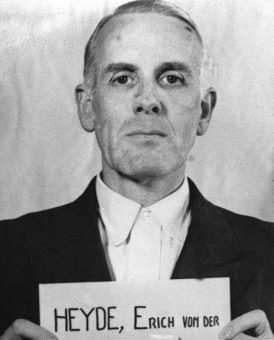Erich von der Heyde (1900–unknown)

© National Archives, Washington, DC
“The details of the reports to Abwehr I […] are something I can no longer recall with clarity. I do recall, however, that they generally were economic in nature, that is, that they portrayed the situation of the country concerned—doubtless, occasionally on the basis of the political situation.”[1]
Erich von der Heyde was born in Hong Kong on May 1, 1900. In 1906 he came to Germany, where he attended school in Bremen and Weimar until May 1918. He served in the military until the end of World War I and then spent the next five years studying agronomy at the Technical University of Munich. In 1925, Erich von der Heyde went to work for a hailstorm insurance company, and in 1926 he changed jobs, joining the agricultural department of I.G. Farben in Ludwigshafen. In 1934, he joined the SS mounted unit, the Reitersturm, and left it again in 1936 with the rank of Hauptscharführer. He retained his membership in the SS, however.
In 1936, Erich von der Heyde became the advisor for nitrogen and agriculture in the Political-Economic Policy Department (WIPO, Wirtschaftspolitische Abteilung) of the I.G. in Berlin, and from mid-1938 he also was the counterintelligence operative of I.G. Farben’s “NW 7” (intelligence) office. His duties there included counterespionage and taking action against breaches of secrecy, and in addition Erich von der Heyde passed on reports from abroad that appeared to be of general interest, distributing them internally at the I.G. and sending them to the Wehrmacht. In this capacity, he was borrowed by the Reich Security Main Office (RSHA, Reichssicherheitshauptamt) and by 1940 had been promoted to Hauptscharführer (SS rank). He had joined the NSDAP in 1937. In September 1940, he was inducted into the Wehrmacht, and until the war’s end in 1945 he served in the military-economic branch of the War Economy and Armament Office (Wehrwirtschafts- und Rüstungsamt; and later the War Economy Staff, or Wehrwirtschaftsstab, as well). In the I.G. Farben Trial at Nuremberg, von der Heyde was acquitted in 1948 on the charges of plundering, spoliation, and mass murder
The editorial team has no information regarding Erich von der Heyde’s subsequent life in the postwar period or his date of death.
(SP; transl. KL)
















